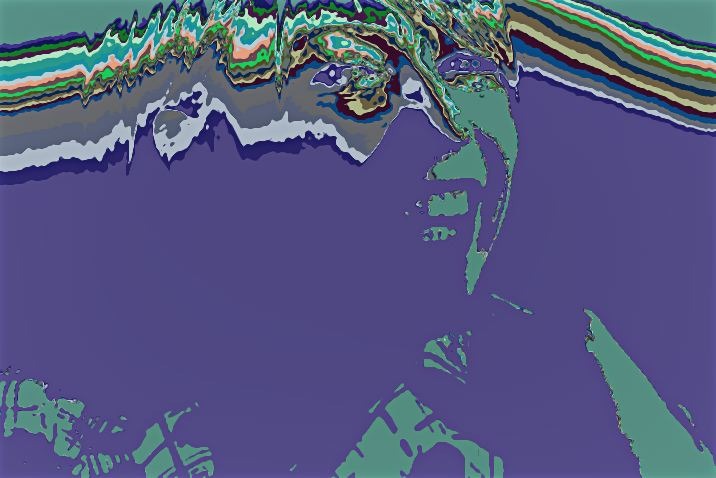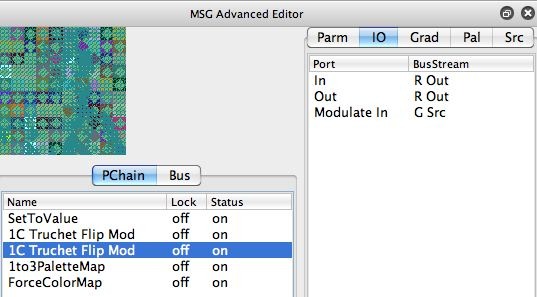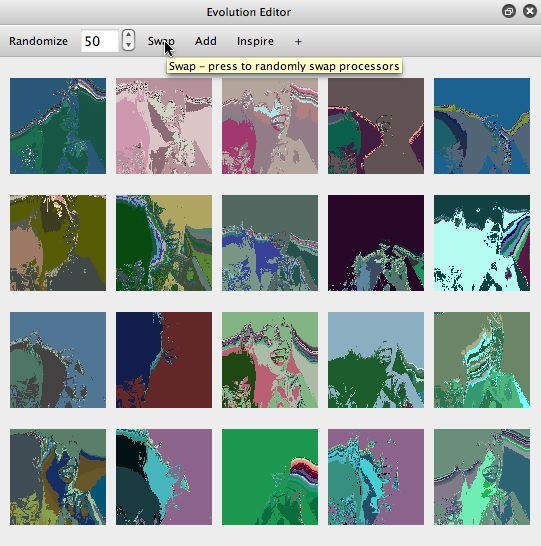The following MSG preset example shown was created by using the Evolution Editor to evolve new MSG presets. I started with the MSG background preset used in the yesterdays post. Directed evolution is a powerful approach to building procedural art and new processing effects. You can work with directed evolution in the Evolution Editor to build new effects without understanding the underlying technical details of how to build and edit MSG presets using the MSG Advanced Editor.
The screen shot gallery below shows the approach I took to build the new MSG effect above. I started with an existing MSG preset, the Truchet patterning stylized background effect used as a part of yesterdays post. The first image in the gallery shows the MSG Advanced Editor loaded with yesterdays’s MSG preset. Note that there are 5 MSG processors in the processor chain editor.
I started my directed evolution session by clicking on the preview image in the top left corner of the MSG Advanced Editor. This loaded the Evolution Editor preview cells with parameter mutated variations of my initial Trucet patterning MSG preset (as seen in the second gallery image).
I then pressed the Swap button at the top of the Evolution Editor. What this button does is run a processor swap mutation on the MSG preset associated with each preview cell in the Evolution Editor. Swap mutation means that a processor is chosen at random, and then a random MSG processor is chosen that has the same IO (input-output) configuration as the original processor, and the new processor is swapped into the processor chain editor list at the position of the old processor. The old processor’s IO stream connections are routed to the new swapped in processor.
Swapping processors is a much more extreme kind of mutation than randomly mutating processor parameters. Mutating processor parameters does not change the underlying nature of the MSG effect. Swapping in new processors can completely change the nature of the underlying MSG effect. Running different swap mutations over time can lead to the evolution of completely new kinds of processing effects.
After each swap mutation, I clicked on the Evolution Editor preview cell I liked the best. When I do this, the preview cells are all replaced with parameter mutated variations of the particular processor chain configuration I clicked on. So swap mutating the preview cells leads to a potentially different effect in each preview cell. Clicking on one of those preview cells then repopulates all of the preview cells with that particular effect (and it’s associated processor chain editing structure).
After several cycles of swap evolution I ended up with the Evolution Editor preview cells shown in the third gallery image. When I clicked on the one I liked the best, it updated the preview cells and also loads itself into the MSG Advanced Editor as the current MSG preset (as seen in the 4th gallery image).
Note that the new processor chain for my new evolved effect has the same number of individual processors as the original MSG preset we started with (5 individual processors). If you compare the IO connections for the 3rd processor in the starting preset and the ending preset you can see that they are the same. Note that the nature of the individual processors is similar, the first processor in both cases generates an image stream, the 2nd and 3rd processors are 1 channel processors with an additional modulation input stream, the 4th processor in both cases converts a 1 channel black and white image to a color image, etc.
Swap mutation is a powerful technique for working with directed evolution to build new MSG processing effects and abstract imagery. I hope the above example of how I used directed evolution working with the MSG Evolution Editor will inspire you to try and build you own custom MSG presets.












Thanks for this site John it is a great way to learn and yes this has introduced me to a new way of building my own custom MSG presets.
If you hold your mouse above the various buttons in the toolbar at the top of the MSG Evolution Editor, the status area at the bottom of the main window displays some help hints for various hot keys that can be used to modify the behavior of the evolution toolbar buttons. For example, holding down shift or option while pressing the Swap button modifies the kind of swap mutation that takes place. There are also lots of different hot keys you can use when pressing a preview cell that will cause different kinds of evolution based on the preview preset you clicked on.Tomorrow’s post covers Add mutation.